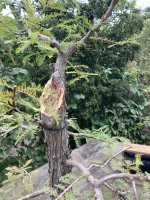BillsBayou
Chumono
Problem: Unnatural symmetry in bald cypress flat-top bonsai.
Cause: Creating a new apex along with new branches at the chop.
Solution: Understanding how symmetry is introduced into your design and avoiding it by doing one thing at a time; New apex or new branch.
Building a flat-top bald cypress can begin with collecting an existing tree from the swamp (numadori). This often begins with a “trunk chop” to establish a starting point. Branches will form near the chop point. The artist might choose one of these new branches to be the apex of the flat-top design. This point of commencement for the curve is a departure from the centerline of the trunk. Multiple branches may form where the numadori’s trunk was chopped. This creates a temptation to create another branch as an opposing branch, or perhaps a second, lower flat-top pad. This is where the artist introduces the problem of symmetry into their design.
In the illustration, the centerline of the trunk becomes the reflection line where the artist creates both their flat-top curve and an opposing branch. The symmetry makes it difficult for the viewer to follow the artist’s design line; the “line of the tree”. The solution to this problem is to either begin the curve of the flat-top design, or to choose one of the new branches to continue following the original line of the numadori. Do not do both. If the trunk-chop is the point of commencement for the flat-top curve, then the artist should not also create an opposing branch. Branches opposing the flat-top curve should be placed above or below this point.
Where the trunk-chop has produced several new branches, if the artist chooses to follow the original centerline, they may also choose to develop a new side branch off of the trunk. Since this side branch is not in opposition to a flat-top’s point of commencement there is no danger of introducing symmetry across the centerline of the trunk. As long as the artist chooses to place the point of commencement above this new branch, symmetry will not confuse the viewer. The point of commencement for the flat-top curve must be clearly discernable to the viewer.

Cause: Creating a new apex along with new branches at the chop.
Solution: Understanding how symmetry is introduced into your design and avoiding it by doing one thing at a time; New apex or new branch.
Building a flat-top bald cypress can begin with collecting an existing tree from the swamp (numadori). This often begins with a “trunk chop” to establish a starting point. Branches will form near the chop point. The artist might choose one of these new branches to be the apex of the flat-top design. This point of commencement for the curve is a departure from the centerline of the trunk. Multiple branches may form where the numadori’s trunk was chopped. This creates a temptation to create another branch as an opposing branch, or perhaps a second, lower flat-top pad. This is where the artist introduces the problem of symmetry into their design.
In the illustration, the centerline of the trunk becomes the reflection line where the artist creates both their flat-top curve and an opposing branch. The symmetry makes it difficult for the viewer to follow the artist’s design line; the “line of the tree”. The solution to this problem is to either begin the curve of the flat-top design, or to choose one of the new branches to continue following the original line of the numadori. Do not do both. If the trunk-chop is the point of commencement for the flat-top curve, then the artist should not also create an opposing branch. Branches opposing the flat-top curve should be placed above or below this point.
Where the trunk-chop has produced several new branches, if the artist chooses to follow the original centerline, they may also choose to develop a new side branch off of the trunk. Since this side branch is not in opposition to a flat-top’s point of commencement there is no danger of introducing symmetry across the centerline of the trunk. As long as the artist chooses to place the point of commencement above this new branch, symmetry will not confuse the viewer. The point of commencement for the flat-top curve must be clearly discernable to the viewer.











